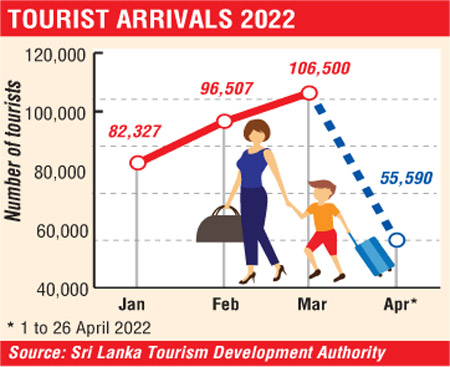Monday Dec 29, 2025
Monday Dec 29, 2025
Friday, 29 April 2022 04:20 - - {{hitsCtrl.values.hits}}
By Charumini de Silva
 Largely due to the current economic and social unrest, tourist arrivals have plunged by 50% in April so far in comparison to March shattering industry hopes for a post-pandemic upturn.
Largely due to the current economic and social unrest, tourist arrivals have plunged by 50% in April so far in comparison to March shattering industry hopes for a post-pandemic upturn.
Provisional data released by the Tourism Ministry, shows arrivals fell by 48% to 55,590 in the first 26 days of April. In contrast March attracted a record 106,500.
Industry experts pointed out that the plunge was due to the Government declaring a State of emergency following the protest in Mirihana, which thereafter drew public to the street countrywide, demanding the administration to step down amidst worsening economic conditions post-independence.
With latest data, year to date tourist arrivals amounted to 340,924 a development thanks to the relatively peaceful period of January to March. Already the industry has seen the surpassing of 2021 full year arrivals of 194,500 and expectations were for a quick rebound in 2022.
However, it is notable that the daily average arrivals have dropped significantly from over 3,600 to 2,148 as of 26 April, which is much lower than the second week midpoint figure of 2,535 tourists.
Last month, Sri Lanka’s monthly tourist arrivals crossed the 100,000 mark for the first time in two years, giving hope for the industry stakeholders that there would be a pandemic revival.
“Our industry is starting to suffer the fallout of economic and political crises at a time when we all hoped it began to recover from the post-pandemic. Although the bookings and cancellations were taking place at a very low pace at the beginning of the month, it has now escalated up to over 50%,” The Hotels Association of Sri Lanka (THASL) President M. Shanthikumar told the Daily FT.
He said the uncertainty prompted cancellations by both business and leisure visitors.
“All members tried to hold on to the reservations made by being very flexible with multiple options because every dollar counts — not just for the industry, but as a country,” he added.
As of 26 April, the UK topped the tourist traffic to Sri Lanka with 10,327, followed by India with 7,900, and Germany with 5,756. In addition, tourists were also received from France, Australia, Russia, Canada, US, Switzerland and Netherlands.
India stands strong as the top tourist source market for Sri Lanka with cumulative number of arrivals at 55,611, followed by UK 41,319, Russia with 40,883, Germany 28,436, France 18,661, Ukraine 13,595, Poland 12,023, Australia 10,072, Canada 8,405 and US 8,384.
Shanthikumar also feared that the numbers would take a nosedive with several airlines having decided to reduce the frequencies they operate into Colombo.
“It is natural for the number of tourist footfalls to drop with fewer airlines flying, but the worry is that it affects our industry and economy at this critical juncture,” he explained.
He reiterated that the drop in arrivals triggered the worsening economic situation with power cuts, shortage of fuel, essential commodities, medicines, political instability, adverse publicity and travel advisory, discontinuation of certain air connectivitites into key source markets and now the reduction in airline frequencies.